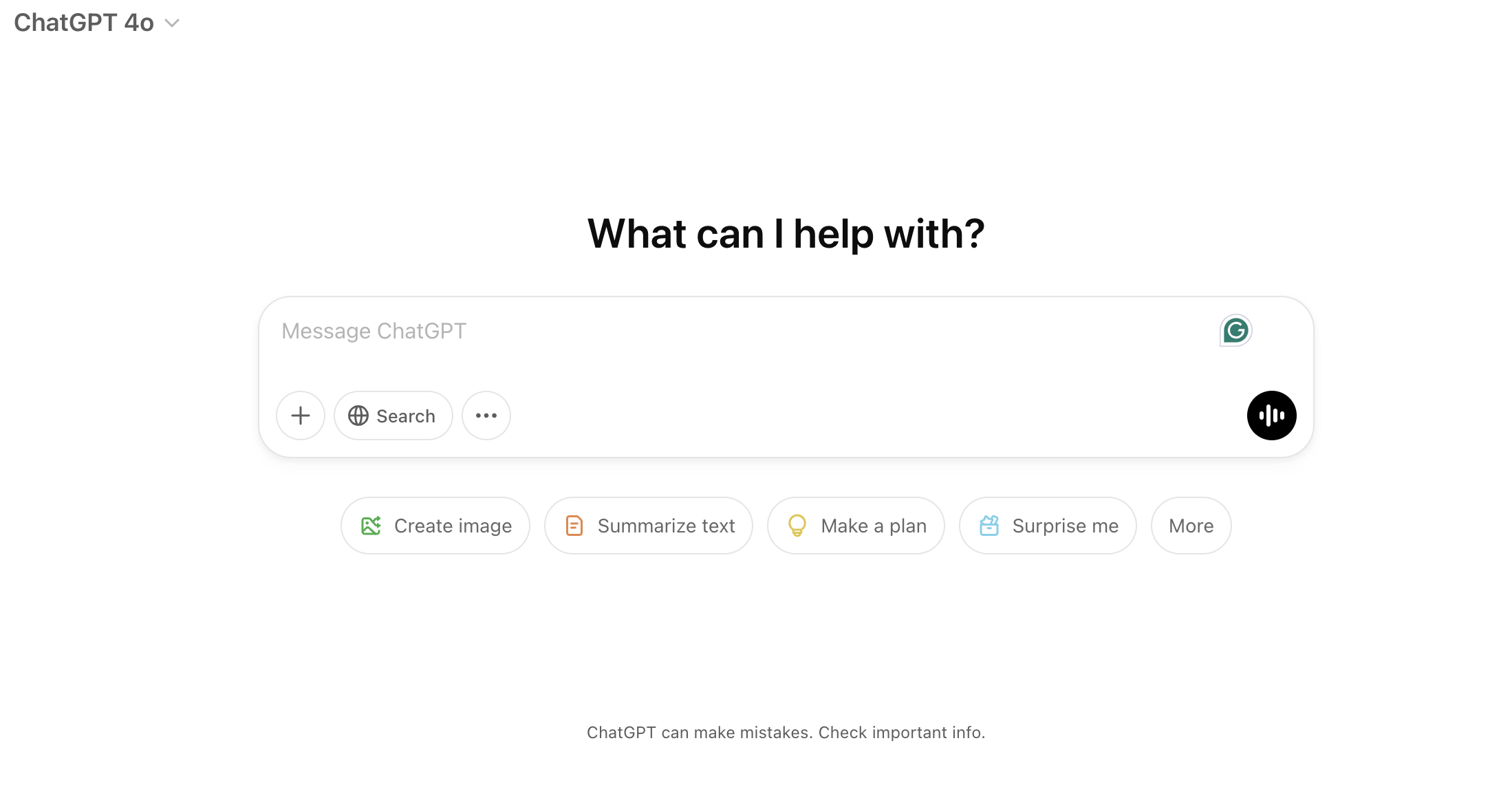Interfacing Chat GPT
Desiree Dighton
Embedded Values and Rhetorical Frames in AI Interfaces
Since its release in November 2022, ChatGPT's interface has included a variety of disclaimers and hedges about the accuracy and safety of its responses. For example, in 2024, a faint message under the chat window stated, “ChatGPT can make mistakes. Check important info” (Figure 3). Such disclaimers detach accuracy and safety from its generated content while continuing to provide that content to users.

These “mistakes” are part of what drives GAI controversies, aversions, and lawsuits. Prior to its initial public release, OpenAI tested and reported that improvements made to GPT-4 to mitigate error and harm are “limited and brittle in some cases” (Abstract, GPT-4 System Card, March 23, 2023). The report acknowledged the need for more safety research in the “absence of anticipatory work to address how best to govern these systems, how to fairly distribute the benefits they generate, and how to fairly share access” (p. 49). The report is especially concerned about GPT’s “latent” capabilities and its knack for “generating discriminatory content favorable to autocratic governments across multiple languages” (p. 51). GAI’s likely impacts, the report stated, reach beyond its content generation to influence knowledge and culture, stating, “AI systems will have even greater potential to reinforce entire ideologies, worldviews, truths and untruths, and to cement them or lock them in, foreclosing future contestation, reflection, and improvement” (p. 49). However, as users interact with ChatGPT’s interface, none of those risks are apparent beyond the faint disclaimer about potential “mistakes” in content generation. ChatGPT’s interface, like other GAI web-based applications, lost many of its conventional Graphical User Interface (GUIs) elements and user options to become more like a conversation portal to powerful but concealed and mysterious processes. GAI chat-based interfaces open opportunities to critically examine the materiality of these designs and track their changes over time. Doing so will give us greater understanding—the critical GAI literacies—to see GPT’s embedded values and how they circulate through its interface versions, user experiences, and public conversations. ChatGPT’s interface enabled widespread use and rapid integration into our personal technologies and other applications, enabling much of GAI’s vast public power. This paper will briefly examine how heuristic interface analysis can unmask interface design as it attempts to hook users, transmit concealed values, and obscure processes. GPT’s affective flirtations, as I’ve termed them, make developing critical GAI literacies especially challenging and important for discerning GAI’s power and place in our classrooms and beyond. Writing classrooms are important sites to check GAI’s power through the interface analysis of its “small but continuous gestures of domination and colonialism” (Selfe & Selfe, p. 486). While many of us realize we may not be able to determine students’ GAI use, building critical literacies in community with them is one avenue we still have for limiting its power.
Analyzing ChatGPT's Interface: A Heuristic Approach
At the time of this writing, GPT’s abilities to generate a response primarily relied on two main design features of its interface: (1) a message box for user prompts and (2) the much larger window streaming GPT's responses. Secondary features included a chat history window, a “new chat” button, and user settings. An icon allowed for sharing chat transcripts, and a question mark icon provided “help” resources, “terms and policies,” and “keyboard shortcuts.” Users could delete chats but couldn’t alter or edit GPT’s responses within the interface window. These design choices and others shape our interactions with the interface and either empower or limit user ability to access a wider range of technical and data possibilities.
Usability Heuristics and the ChatGPT Interface
Jakob Nielsen (1992) first championed heuristic interface evaluation to identify “usability problems” (p. 373), defined as aspects that hinder understanding, use, or satisfaction. Nielsen advocated for evaluators to assess compliance “with recognized usability principles” (1992, p. 373). Today, these principles guide heuristic and ergonomic evaluation methods standard in contemporary interface design, development, and evaluation. Pribeanu (2017) noted that interface design includes user guidance, including prompting, feedback, information architecture, and grouping to enhance usability while also guiding users toward the intended uses imagined by companies, programmers, and designers. In chat-based GAI interfaces, typical dropdown and other options are mostly absent, constraining agency within the chat window and the users’ abilities to use conversation, or prompting, to achieve an output.
In a 2023 OpenBootcamp UX/UI Challenge using Nielsen-based heuristics, Athul Anil (2023) found GPT’s interface passed every design standard except for a “minor usability problem related to aesthetic and minimalistic design” (n.p.). In his redesign recommendations, Anil recommended more minimalism, eliminating interactive elements to reduce visual clutter. Anil's assessment of ChatGPT's interface indicates that at least in some UI/UX circle, ChatGPT’s interface is a nearly flawless design. But for what and whom is it designed?
